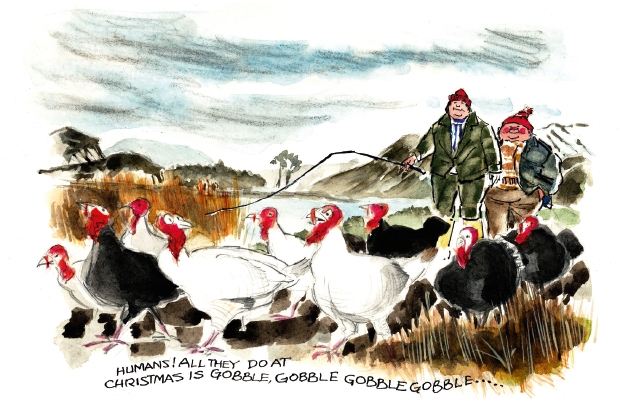Christmas is a time of celebration and giving thanks. In the old days we did this by feasting on meat. Whether it was a goose or a turkey at the centre of the table, it was a treat. The whole family would understand where the animal came from and perhaps have contributed to feeding, killing and preparing it. Every morsel would be appreciated. Nothing would be wasted.
Somewhere along the way, we have forgotten this. We eat meat all year round, including turkey. We have little idea of how the bird was raised, slaughtered or even cooked. We just gobble it up without a thought and the bones go in the bin.
Call it middle-class angst, but I’ve been worrying about this. If I’m going to eat meat, I want to be an ‘ethical carnivore’. I want to know exactly where it comes from. Also, I want it to taste good. So I decided to visit some of the most free-range turkeys in Britain to discover how to rear, kill and pluck your own Christmas dinner.
Lucy Beattie raises 50 to 100 turkeys every year to supplement her income. The turkeys fit in quite happily at her family’s small Scottish farm, scratching around close to the house for a few months and roosting at night in the barn to avoid a resident pine marten. When I arrive the lucky ones are guddling around the shore of Loch Broom. They look magnificent, even more so against a backdrop of snowy mountains, their constant gobbling more musical than you would expect.
Every year around 18 million turkeys are slaughtered in the UK, 10 million of them at Christmas. Most stay indoors in huge ventilated barns with sawdust on the floor and a minimum of eight hours’ artificial light. Even ‘free range’ turkeys have a space barely the size of a dozen copies of The Spectator to scratch around in. They grow to a full weight of around 5kg in just nine to 12 weeks.
Ever wondered why your turkey is dry? It’s not because you failed to get up at 4 a.m. to baste the damn thing or ignored Delia’s instructions; it’s because it has no fat to marble the meat. It is a mere child, a teenager which has yet to put on fat before breeding. It is pure protein; fine if you are on a diet, but really, for a feast?
Lucy’s turkeys live twice as long, ranging all around the farm and even crossing the burn to harass the neighbour’s collie. Their muscles are exercised and fat can develop, too. And what’s wrong with fat, after all? Especially when it bubbles under the skin to create a crisp golden crust to sink your teeth into.
It is possible to raise your own ‘golden turkeys’. Buy poults in summer and let them range around the garden, plumping up for Christmas. It may be a chance to educate children about where their festive meal comes from — though they will have to face the inevitable when the time comes.
Home slaughter is more complicated and you should educate yourself or get in an expert. Lucy did a course with the Humane Slaughter Association and made a rudimentary slaughter unit by cutting the ends off traffic cones and sticking them upside down in a wooden table. The turkeys are gently lowered in until only their heads stick out. Lucy moves in with her electric stunner and counts for ‘10 elephants’. I watch the huge turkey feet stretch out and splay, like dinosaur prints. Then it is over. The throat is cut and blood tinkles into a plastic bucket. ‘I’m the softest person I know,’ she says quietly. ‘I just have to get on with it.’ It’s not a pleasant thing to watch but I am not as upset as I thought I would be. The fact is I trust Lucy and I’m not sure I trust Bernard Matthews or Tesco, or even Waitrose.
Turkeys grown on small farms are usually killed on site and processed by local people. Even if only once, I want to prepare the bird myself. I start plucking, white feathers floating to the ground. I want to say it looks festive, like falling snow, but honestly? The bulbous blue nose or ‘snood’ hangs over the beak soaked in blood and the outer feathers are stiff and yellow. Only the soft underfeathers are downy white.
In an abattoir, turkeys are dipped in a scalding tank then put through plucking machines. This takes away more of the tasty fat. This ‘wet pluck’ also means they cannot be hung for a couple of weeks to develop more flavour, because of the risk of bacteria developing in the damp meat.
To ensure a turkey is ‘dry-plucked’, properly free-range and slow-grown, look out for the Golden Turkey quality assurance or, next year, do it yourself. For a really fine breast, finish your turkey with tweezers. I pluck away until I have a bird worthy of a Victorian feast. My feet are freezing and my hands stink but I have a real appreciation of the hard work that goes into raising a bird. And isn’t that so much better than buying it from the supermarket?






Comments